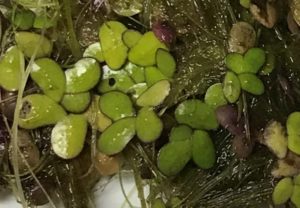Non-Native

Landoltia punctata
More Info & Photos of Dotted Duckweed
Non-Herbicide Management Options
1. Physical Management Options
Duckweed can be removed by raking or seining it from the pond’s surface.
2. Biological Management Options
Tilapia will consume dotted duckweed but are a warm water species that cannot survive in temperatures below 55 F. Therefore, tilapia usually cannot be stocked before mid-April or May and will die in November or December. Recommended stocking rates are 15 to 20 pounds of mixed sex adult Mozambique Tilapia (Oreochromis mossambicus) per surface area. Tilapia are often not effective for vegetation control if the pond has a large bass population due to intense predation. In Texas, stocking Mozambique Tilapia requires approval from the Texas Parks and Wildlife Department if the pond is in the designated “conservation zone” to ensure tilapia cannot escape and negatively impact imperiled native fishes. Tilapia must be purchased from a permitted seller regardless of zone. In other states, check with your County Extension Agent for the legality of stocking tilapia.
Ducks will eat duckweed, but they seldom control it.
Herbicide Control Options
Always read the product label for directions and precautions, as the label is the law. Click on the name of the product to see the label. Read the label for specific water use restrictions.
The active ingredients that have been successful in treating duckweed include:
- Carfentrazone (Rated: Excellent)
- Diquat (Rated: Good)
- Fluridone (Rated: Excellent)
- Flumioxazin (Rated: Excellent)
- Penoxsulam (Rated: Excellent)
These rating are based upon the U.S. Army Corps of Engineers aquatic herbicide trials.
1) Carfentrazone
Carfentrazone is a contact herbicide that is absorbed through the leaves. Contact herbicides act quickly and kill all plant cells they come in contact with.
Common trade and product names include but are not limited to:
2) Diquat
Diquat is a contact algaecide and herbicide. Contact herbicides act quickly and kill all plant cells they come in contact with.
Common trade or product names include but are not limited to:
3) Fluridone
Fluridone is a broad spectrum, systemic herbicide. Systemic herbicides are absorbed and move within the plant to the site of action. Systemic herbicides tend to act more slowly than contact herbicides.
Common trade and product names include but are not limited to:
4) Flumioxazin
Flumioxazin is a water dispensable granule that is to be sprayed or injected after mixing. It is a broad spectrum, contact herbicide. Contact herbicides act quickly. Flumioxazin should be applied to actively growing plants and a surfactant (a substance that reduces water tension) will be needed if the herbicide is applied to foliage of floating or emergent plants. Water pH needs to be below 8.5 or flumioxazin will rapidly degrade and lose effectiveness.
Common trade and product names include but are not limited to:
5) Penoxsulam
Penoxsulam is a broad spectrum, systemic herbicide. Systemic herbicides are absorbed and move within the plant to the site of action. Systemic herbicides tend to act more slowly than contact herbicides. It may be sprayed directly onto emergent plants or applied directly into the water. Penoxsulam should not be applied in areas where it will be diluted rapidly. This herbicide will need a registered surfactant (see the label) for leaf and exposed sediment applications.
Common trade and product names include but are not limited to:
Precautions
One danger with any chemical control method is the chance of an oxygen depletion after the treatment caused by the decomposition of the dead plant material. Oxygen depletion can kill fish in the pond. If the pond is heavily infested with weeds, it may be possible (depending on the herbicide chosen) to treat the pond in sections and let each section decompose for about two weeks before treating another section. Aeration, particularly at night, for several days after treatment may help control the oxygen depletion.
One common problem in using aquatic herbicides is determining area and/or volume of the pond or area to be treated. To assist you with these determinations see SRAC #103 Calculating Area and Volume of Ponds and Tanks.
Many aquatically registered herbicides have water use restrictions (See General Water Use Restrictions).
To see the labels for these products click on the name. Always read and follow all label directions. Check label for specific water use restrictions.
Cultivation Options
This is a non-native plant that should not be grown as it is invasive and illegal to possess or transport this species in Texas. Please report sightings to the Texas Parks and Wildlife Department at (512) 389-4800.
Questions?
If you need assistance, contact the Ag & Natural Resources agent in your county or hire a professional.